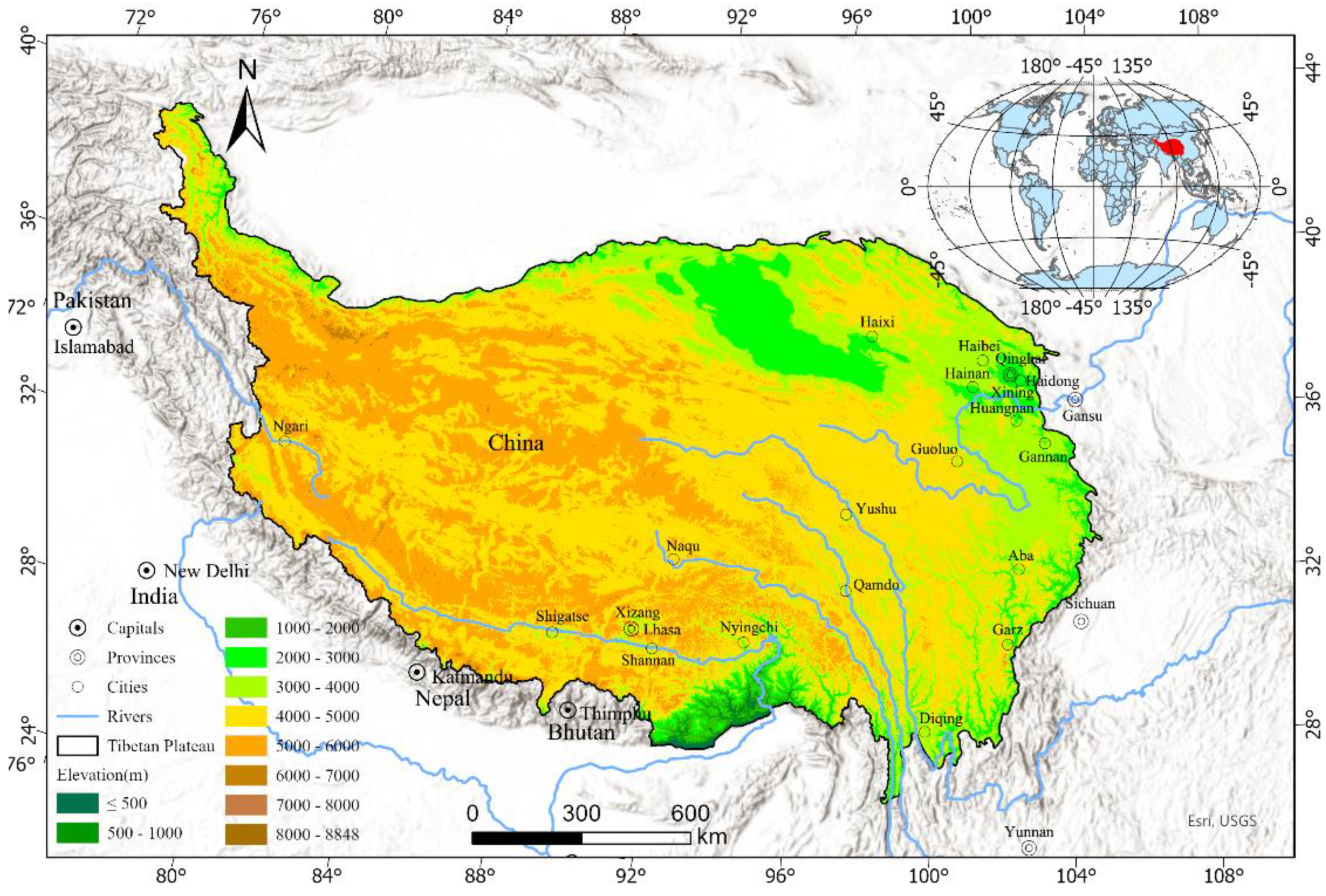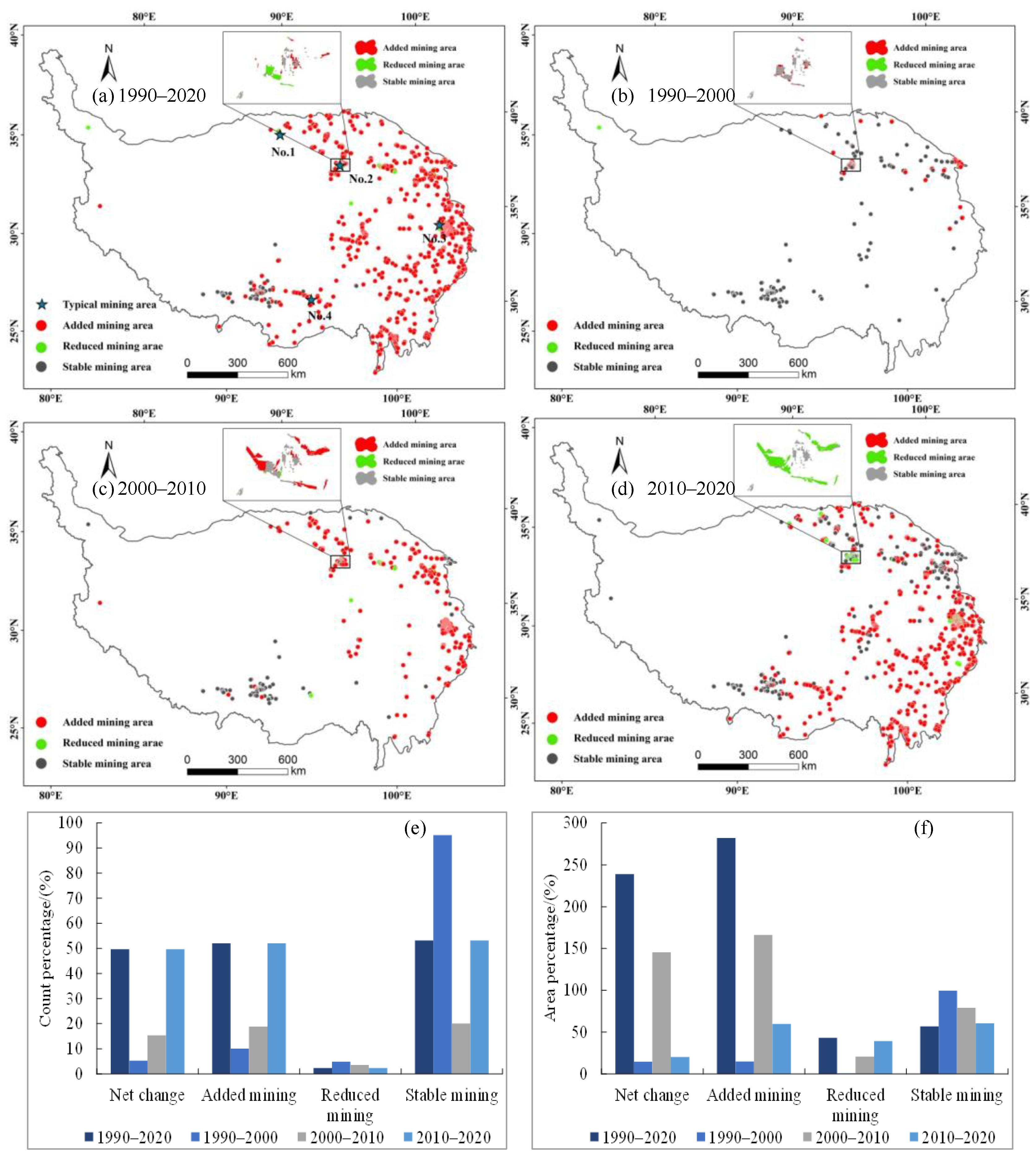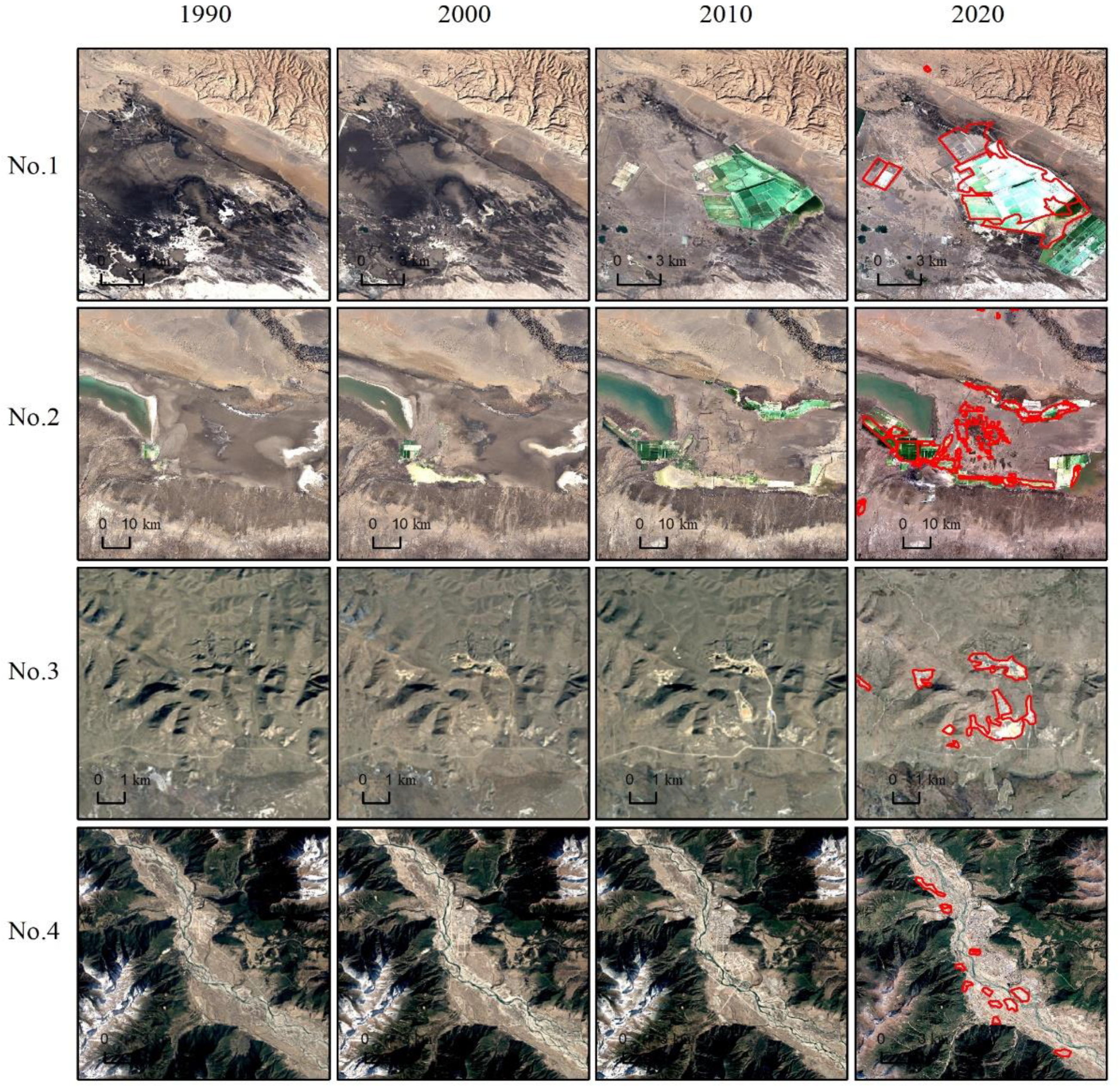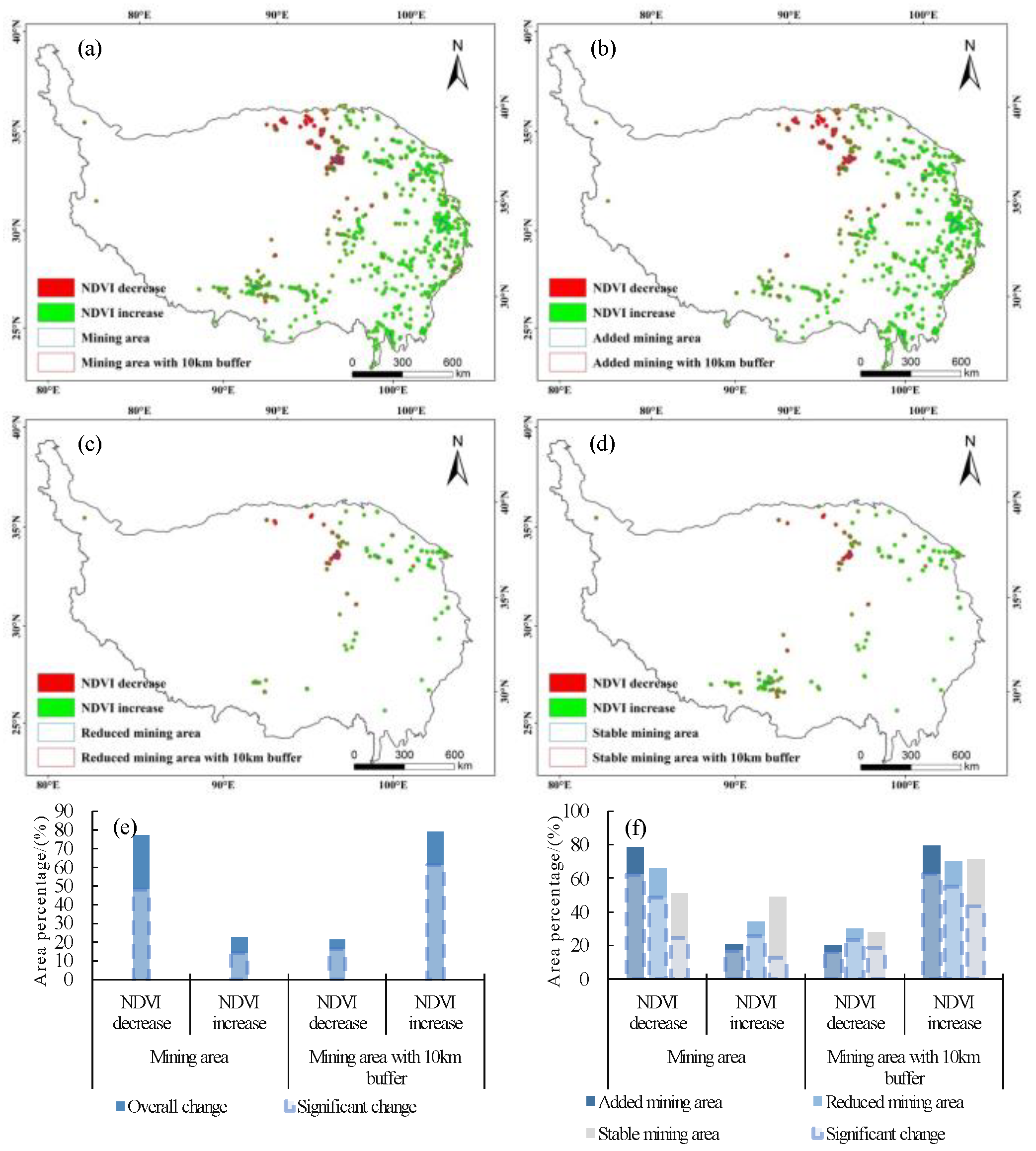Complex Ecosystem Impact of Rapid Expansion of Industrial and Mining Land on the Tibetan Plateau
Abstract
:1. Introduction
2. Materials and Methods
2.1. Study Area
2.2. Data Resources
2.2.1. Land Use Datasets
2.2.2. Normalized Difference Vegetation Index
2.3. Methods
2.3.1. Landscape Change
2.3.2. Change Detection Using Normalized Difference Vegetation Index
2.3.3. Equivalent Value Factors Method
3. Results
3.1. Distribution and Expansion of Industrial and Mining Land on the Tibetan Plateau
3.2. Landscape Change in Industrial and Mining Land
3.3. Comparison of Normalized Difference Vegetation Index Changing Trends between Industrial and Mining Land and its 10 km Buffer
3.4. Differentiation of Ecological Services Value in Industrial and Mining Land and Its 10 km Buffer
4. Discussion
4.1. Expansion of Industrial and Mining Land and Its Effects on Ecological Services Value
4.2. Effect of Expansion of Industrial and Mining Land on Vegetation Index
4.3. Limitations and Future Outlook
5. Conclusions
Supplementary Materials
Author Contributions
Funding
Data Availability Statement
Acknowledgments
Conflicts of Interest
References
- Shou, S.W.; Wei, Z.; Dan, W.X.; Yu, X.L.; Adjei, K.; Amaning. Research on Ecological Carrying Capacity and Sustainable Development in Tibet; China Environmental Science Press: Beijing, China, 2015. [Google Scholar]
- Kumar, A.; Maiti, S.K. Assessment of potentially toxic heavy metal contamination in agricultural fields, sediment, and water from an abandoned chromite-asbestos mine waste of Roro hill, Chaibasa, India. Environ. Earth Sci. 2015, 74, 2617–2633. [Google Scholar] [CrossRef]
- Ahirwal, J.; Maiti, S.K. Assessment of soil properties of different land uses generated due to surface coal mining activities in tropical Sal (Shorea robusta) forest, India. Catena 2016, 140, 155–163. [Google Scholar] [CrossRef]
- Feng, Y.; Wang, J.; Bai, Z.; Reading, L. Effects of surface coal mining and land reclamation on soil properties: A review. Earth-Science Rev. 2019, 191, 12–25. [Google Scholar] [CrossRef]
- Borrelli, P.; Panagos, P.; Ballabio, C.; Lugato, E.; Weynants, M.; Montanarella, L. Towards a Pan-European Assessment of Land Susceptibility to Wind Erosion. Land Degrad. Dev. 2016, 27, 1093–1105. [Google Scholar] [CrossRef]
- Wong, M. Ecological restoration of mine degraded soils, with emphasis on metal contaminated soils. Chemosphere 2002, 50, 775–780. [Google Scholar] [CrossRef]
- Xia, H.; Cai, X. Ecological restoration technologies for mined lands: A review. Ying Yong Sheng Tai Xue Bao 2002, 13, 1471–1477. [Google Scholar]
- Chen, B.; Zhang, X.; Tao, J.; Wu, J.; Wang, J.; Shi, P.; Zhang, Y.-J.; Yu, C. The impact of climate change and anthropogenic activities on alpine grassland over the Qinghai-Tibet Plateau. Agric. For. Meteorol. 2014, 189–190, 11–18. [Google Scholar] [CrossRef]
- Liu, X.; Pei, F.; Wen, Y.; Li, X.; Wang, S.; Wu, C.; Cai, Y.; Wu, J.; Chen, J.; Feng, K.; et al. Global urban expansion offsets climate-driven increases in terrestrial net primary productivity. Nat. Commun. 2019, 10, 1–8. [Google Scholar] [CrossRef] [Green Version]
- Guan, X.; Shen, H.; Li, X.; Gan, W.; Zhang, L. A long-term and comprehensive assessment of the urbanization-induced impacts on vegetation net primary productivity. Sci. Total Environ. 2019, 669, 342–352. [Google Scholar] [CrossRef]
- Maus, V.; Giljum, S.; Gutschlhofer, J.; Da Silva, D.M.; Probst, M.; Gass, S.L.B.; Luckeneder, S.; Lieber, M.; McCallum, I. A global-scale data set of mining areas. Sci. Data 2020, 7, 1–13. [Google Scholar] [CrossRef]
- Prior, T.; Giurco, D.; Mudd, G.; Mason, L.; Behrisch, J. Resource depletion, peak minerals and the implications for sustainable resource management. Glob. Environ. Change 2012, 22, 577–587. [Google Scholar] [CrossRef]
- Winkler, K.; Fuchs, R.; Rounsevell, M.; Herold, M. Global land use changes are four times greater than previously estimated. Nat. Commun. 2021, 12, 1–10. [Google Scholar] [CrossRef] [PubMed]
- Obodai, J.; Adjei, K.A.; Odai, S.N.; Lumor, M. Land use/land cover dynamics using landsat data in a gold mining basin-the Ankobra, Ghana. Remote Sens. Appl. Soc. Environ. 2018, 13, 247–256. [Google Scholar] [CrossRef]
- Nanos, N.; Martin, J.A.R. Multiscale analysis of heavy metal contents in soils: Spatial variability in the Duero river basin (Spain). Geoderma 2012, 189–190, 554–562. [Google Scholar] [CrossRef]
- Upadhyay, N.; Verma, S.; Singh, A.P.; Devi, S.; Vishwakarma, K.; Kumar, N.; Pandey, A.; Dubey, K.; Mishra, R.; Tripathi, D.K.; et al. Soil ecophysiological and microbiological indices of soil health: A study of coal mining site in sonbhadra, uttar Pradesh. J. Soil Sci. Plant Nutr. 2016, 16, 778–800. [Google Scholar] [CrossRef] [Green Version]
- Kumi-Boateng, B.; Mireku-Gyimah, D.; Duker, A.A. A spatio-temporal based estimation of vegetation changes in the Tarkwa Mining Area of Ghana. Res. J. Environ. Earth Sci. 2012, 4, 215–229. [Google Scholar]
- Liu, S.; Li, W.; Qiao, W.; Wang, Q.; Hu, Y.; Wang, Z. Effect of natural conditions and mining activities on vegetation variations in arid and semiarid mining regions. Ecol. Indic. 2019, 103, 331–345. [Google Scholar] [CrossRef]
- Li, J.; Liang, J.; Wu, Y.; Yin, S.; Yang, Z.; Hu, Z. Quantitative evaluation of ecological cumulative effect in mining area using a pixel-based time series model of ecosystem service value. Ecol. Indic. 2020, 120, 106873. [Google Scholar] [CrossRef]
- Liu, X.; Zhou, W.; Bai, Z. Vegetation coverage change and stability in large open-pit coal mine dumps in China during 1990–2015. Ecol. Eng. 2016, 95, 447–451. [Google Scholar] [CrossRef]
- Firozjaei, M.K.; Sedighi, A.; Firozjaei, H.K.; Kiavarz, M.; Homaee, M.; Arsanjani, J.J.; Makki, M.; Naimi, B.; Alavipanah, S.K. A historical and future impact assessment of mining activities on surface biophysical characteristics change: A remote sensing-based approach. Ecol. Indic. 2020, 122, 107264. [Google Scholar] [CrossRef]
- Wang, J.; Dai, J.; Wu, Y. Remote Sensing Survey of the Eco—Geological Environment in the Duolong Mining Area. Tibet. Geol. Explor. 2018, 54, 781–790. [Google Scholar]
- Yu, H.; Zheng, Z.; Cheng, S.; Gao, Y.; Yang, G. The Study on Ecological Environment Status and Protection of Mine in Tibet—Taking Placer Gold Mine in North Tibet for Example. J. Sichuan Norm. Univ. 2011, 34, 260–266. [Google Scholar]
- Lu, Y.; Hao, W.; Cai, L. Review of remote sensing investigation of mineral resources development status in eastern Tibet. Geol. Surv. Chin. 2016, 3, 35–40. [Google Scholar]
- Wu, Z.; Lei, S.; Lu, Q.; Bian, Z.; Ge, S. Spatial distribution of the impact of surface mining on the landscape ecological health of semi-arid grasslands. Ecol. Indic. 2019, 111, 105996. [Google Scholar] [CrossRef]
- Li, S.; Zhang, H.; Zhou, X.; Yu, H.; Li, W. Enhancing protected areas for biodiversity and ecosystem services in the Qinghai–Tibet Plateau. Ecosyst. Serv. 2020, 43, 101090. [Google Scholar] [CrossRef]
- Zhang, Y.; Qi, W.; Zhou, C.; Ding, M.; Liu, L.; Gao, J.; Bai, W.; Wang, Z.; Zheng, D. Spatial and temporal variability in the net primary production of alpine grassland on the Tibetan Plateau since 1982. J. Geogr. Sci. 2014, 24, 269–287. [Google Scholar] [CrossRef]
- Wang, X.; Zhang, Y.; Wu, X.; Zheng, D.; Wang, Z.; Yan, J.; Liu, L.; Zhang, B.; Zhao, Z.; Bai, W.; et al. Spatial and temporal characteristics of land use and cover changes in the Tibetan Plateau. Chin. Sci. Bull. 2019, 64, 2865–2875. [Google Scholar] [CrossRef] [Green Version]
- Mima, D. Study on the Model of Green Mining Economics with Ecotone in Tibet Autonomous Region of PRC; University of Geosciences: Wuhan, China, 2017. [Google Scholar]
- Li, S.; Bing, Z.; Jin, G. Spatially Explicit Mapping of Soil Conservation Service in Monetary Units Due to Land Use/Cover Change for the Three Gorges Reservoir Area, China. Remote. Sens. 2019, 11, 468. [Google Scholar] [CrossRef] [Green Version]
- Fu, J.; Jiang, D.; Huang, Y. 1 km grid population dataset of China (2005, 2010). Acta Geogr. Sin. 2014, 69, 136–139. [Google Scholar] [CrossRef]
- He, Z.; Du, J.; Chen, L.; Zhu, X.; Lin, P.; Zhao, M.; Fang, S. Impacts of recent climate extremes on spring phenol-ogy in arid-mountain ecosystems in China. Agr. Forest Meteorol. 2018, 260, 31–40. [Google Scholar] [CrossRef]
- Liu, J.Y.; Zhuang, D.F.; Luo, D.; Xiao, X. Land-cover classification of China: Integrated analysis of AVHRR im-agery and geophysical data. Int. J. Remote Sens. 2003, 24, 2485–2500. [Google Scholar] [CrossRef]
- Sun, J.; Wang, X.; Chen, A.; Ma, Y.; Cui, M.; Piao, S. NDVI indicated characteristics of vegetation cover change in China’s metropolises over the last three decades. Environ. Monit. Assess. 2010, 179, 1–14. [Google Scholar] [CrossRef] [PubMed]
- Yao, R.; Cao, J.; Wang, L.; Zhang, W.; Wu, X. Urbanization effects on vegetation cover in major African cities during 2001–2007. Int. J. Appl. Earth Obs. Geoinf. 2019, 75, 44–53. [Google Scholar] [CrossRef]
- Sun, Y.; Zhao, S.; Qu, W. Quantifying spatiotemporal patterns of urban expansion in three capital cities in Northeast China over the past three decades using satellite data sets. Environ. Earth Sci. 2014, 73, 7221–7235. [Google Scholar] [CrossRef]
- Tobler, W.R. A Computer Movie Simulating Urban Growth in the Detroit Region. Econ. Geogr. 1970, 46, 234–240. [Google Scholar] [CrossRef]
- Gorelick, N.; Hancher, M.; Dixon, M.; Ilyushchenko, S.; Thau, D.; Moore, R. Google Earth Engine: Planetary-scale geospatial analysis for everyone. Remote Sens. Environ. 2017, 202, 18–27. [Google Scholar] [CrossRef]
- Xiang, J.; Li, X.; Xiao, R.; Wang, Y. Effects of land use transition on ecological vulnerability in poverty-stricken mountainous areas of China: A complex network approach. J. Environ. Manag3. 2021, 297, 113206. [Google Scholar] [CrossRef]
- Tosic, I. Spatial and temporal variability of winter and summer precipitation over Serbia and Montenegro. Arch. Meteorol. Geophys. Bioclimatol. Ser. B 2004, 77, 47–56. [Google Scholar] [CrossRef]
- Kendall, M.G. Rank Correlation Methods. J. Inst. Actuar. 1949. [Google Scholar] [CrossRef]
- Jiang, W.; Wu, T.; Fu, B. The value of ecosystem services in China: A systematic review for twenty years. Ecosyst. Serv. 2021, 52, 101365. [Google Scholar] [CrossRef]
- Xie, G.; Zhang, C.; Zhang, L.; Chen, W.; Li, S. Improvement of the Evaluation Method for Ecosystem Service Value Based on Per Unit Area. J. Nat. Res. 2015, 30, 1243–1254. [Google Scholar]
- Xu, L.; Xu, X.; Luo, T.; Zhu, G.; Ma, Z. Services based on land use: A case study of Bohai Rim. Geographical re-search. Geogr. Res. 2012, 31, 1775–1784. [Google Scholar] [CrossRef]
- Zhang, L.; Yu, X.; Jiang, M.; Xue, Z.; Lu, X.; Zou, Y. A consistent ecosystem services valuation method based on Total Economic Value and Equivalent Value Factors: A case study in the Sanjiang Plain, Northeast China. Ecol. Complex. 2017, 29, 40–48. [Google Scholar] [CrossRef]
- Gutman, G.; Ignatov, A. The derivation of the green vegetation fraction from NOAA/AVHRR data for use in numerical weather prediction models. Int. J. Remote Sens. 1998, 19, 1533–1543. [Google Scholar] [CrossRef]
- Bi, X.; Ge, J. Evaluating Ecosystem Service Valuation in China Based on the IGBP Land Cover Datasets. J. Mt. Sci. 2004, 22, 48–53. [Google Scholar]
- Zhang, C.; Kuang, W.; Wu, J.; Liu, J.; Tian, H. Industrial land expansion in rural China threatens environmental securities. Front. Environ. Sci. Eng. 2020, 15, 1–13. [Google Scholar] [CrossRef]
- Jiang, W.; Lü, Y.; Liu, Y.; Gao, W. Ecosystem service value of the Qinghai-Tibet Plateau significantly increased during 25 years. Ecosyst. Serv. 2020, 44, 101146. [Google Scholar] [CrossRef]
- Liu, A.; Kuang, W.; Ding, F.; Yan, H.; Yang, T. Impacts of urban and industrial land expansion on net primary productivity of China during 2000–2015. Arid Land Geogr. 2017, 40, 805–816. [Google Scholar]
- Zhang, G.; Zheng, D.; Xie, L.; Zhang, X.; Wu, H.; Li, S. Mapping changes in the value of ecosystem services in the Yangtze River Middle Reaches Megalopolis, China. Ecosyst. Serv. 2021, 48, 101252. [Google Scholar] [CrossRef]
- Xiao, W.; Zhang, W.; Ye, Y.; Lv, X.; Yang, W. Is underground coal mining causing land degradation and significantly damaging ecosystems in semi-arid areas? A study from an Ecological Capital perspective. Land Degrad. Dev. 2020, 31, 1969–1989. [Google Scholar] [CrossRef]
- Wu, Z.; Lei, S.; Lu, Q.; Bian, Z. Impacts of Large-Scale Open-Pit Coal Base on the Landscape Ecological Health of Semi-Arid Grasslands. Remote Sens. 2019, 11, 1820. [Google Scholar] [CrossRef] [Green Version]
- Du, J.; Fu, Q.; Fang, S.; Wu, J.; He, P.; Quan, Z. Effects of rapid urbanization on vegetation cover in the metropolises of China over the last four decades. Ecol. Indic. 2019, 107, 105458. [Google Scholar] [CrossRef]
- Zhao, S.Q.; Liu, S.G.; Zhou, D.C. Prevalent vegetation growth enhancement in urban environment. Proc. Natl. Acad. Sci. USA 2016, 113, 6313–6318. [Google Scholar] [CrossRef] [PubMed] [Green Version]
- Li, L.; Zhang, Y.; Liu, L.; Wu, J.; Wang, Z.; Li, S.; Zhang, H.; Zu, J.; Ding, M.; Paudel, B. Spatiotemporal Patterns of Vegetation Greenness Change and Associated Climatic and Anthropogenic Drivers on the Tibetan Plateau during 2000–2015. Remote Sens. 2018, 10, 1525. [Google Scholar] [CrossRef] [Green Version]
- Li, C.; de Jong, R.; Schmid, B.; Wulf, H.; Schaepman, M. Spatial variation of human influences on grassland biomass on the Qinghai-Tibetan plateau. Sci. Total Environ. 2019, 665, 678–689. [Google Scholar] [CrossRef]
- Hou, H.; Wang, R.; Murayama, Y. Scenario-based modelling for urban sustainability focusing on changes in cropland under rapid urbanization: A case study of Hangzhou from 1990 to 2035. Sci. Total Environ. 2019, 661, 422–431. [Google Scholar] [CrossRef]
- Hou, X.-Y.; Liu, S.-L.; Cheng, F.-Y.; Zhang, Y.-Q.; Dong, S.-K.; Su, X.-K.; Liu, G.-H. Vegetation community composition along disturbance gradients of four typical open-pit mines in Yunnan Province of southwest China. Land Degrad. Dev. 2018, 30, 437–447. [Google Scholar] [CrossRef]
- Liu, W.; Agusdinata, D.B.; Myint, S.W. Spatiotemporal patterns of lithium mining and environmental degradation in the Atacama Salt Flat, Chile. Int. J. Appl. Earth Obs. Geoinf. 2019, 80, 145–156. [Google Scholar] [CrossRef]
- Van Vliet, J. Direct and indirect loss of natural area from urban expansion. Nat. Sustain. 2019, 2, 755–763. [Google Scholar] [CrossRef]
- Carlson, T.N.; Ripley, D.A. On the relation between NDVI, fractional vegetation cover, and leaf area index. Remote Sens. Environ. 1997, 62, 241–252. [Google Scholar] [CrossRef]
- Chen, A.; Huang, L.; Liu, Q.; Piao, S. Optimal temperature of vegetation productivity and its linkage with climate and elevation on the Tibetan Plateau. Glob. Chang. Biol. 2021, 27, 1942–1951. [Google Scholar] [CrossRef] [PubMed]
- Pang, G.; Wang, X.; Yang, M. Using the NDVI to identify variations in, and responses of, vegetation to climate change on the Tibetan Plateau from 1982 to 2012. Quat. Int. 2016, 444, 87–96. [Google Scholar] [CrossRef]
- Camps-Valls, G.; Campos-Taberner, M.; Moreno-Martínez, A.; Walther, S.; Duveiller, G.; Cescatti, A.; Mahecha, M.D.; Muñoz-Marí, J.; García-Haro, F.J.; Guanter, L.; et al. A unified vegetation index for quantifying the terrestrial biosphere. Sci. Adv. 2021, 7, eabc7447. [Google Scholar] [CrossRef] [PubMed]
- Costanza, R.; D’Arge, R.; De Groot, R.; Farber, S.; Grasso, M.; Hannon, B.; Limburg, K.; Naeem, S.; O’Neill, R.V.; Paruelo, J. The value of the world’s ecosystem services and natural capital. Nature 1997, 387, 253–260. [Google Scholar] [CrossRef]
- Costanza, R.; de Groot, R.; Sutton, P.; van der Ploeg, S.; Anderson, S.J.; Kubiszewski, I.; Farber, S.; Turner, R.K. Changes in the global value of ecosystem services. Glob. Environ. Change 2014, 26, 152–158. [Google Scholar] [CrossRef]












| Ecosystem Service | Land Types | Cultivated Land | Forest | Grassland | Wetland | Wilderness | Waters |
|---|---|---|---|---|---|---|---|
| Supply service | Food production | 1.86 | 0.85 | 0.59 | 0.43 | 0.01 | 0.67 |
| Raw material production | 0.41 | 1.95 | 0.87 | 0.42 | 0.03 | 0.19 | |
| Water supply | −2.19 | 1.01 | 0.48 | 2.18 | 0.02 | 8.78 | |
| Adjustment services | Gas regulation | 1.50 | 6.41 | 3.04 | 1.60 | 0.11 | 0.80 |
| Climate regulation | 0.78 | 19.18 | 8.04 | 3.02 | 0.08 | 2.38 | |
| Purify the environment | 0.23 | 5.62 | 2.65 | 3.02 | 0.34 | 4.80 | |
| Hydrological regulation | 2.51 | 12.55 | 5.89 | 20.35 | 0.20 | 91.87 | |
| Support services | Soil conservation | 0.87 | 7.80 | 3.70 | 1.94 | 0.13 | 0.78 |
| Maintain nutrient cycle | 10.24 | 0.60 | 0.29 | 0.15 | 0.01 | 0.06 | |
| Biodiversity | 0.29 | 7.11 | 3.37 | 6.61 | 0.12 | 2.15 | |
| Cultural services | Aesthetic landscape | 0.13 | 3.12 | 1.49 | 3.97 | 0.05 | 1.66 |
Publisher’s Note: MDPI stays neutral with regard to jurisdictional claims in published maps and institutional affiliations. |
© 2022 by the authors. Licensee MDPI, Basel, Switzerland. This article is an open access article distributed under the terms and conditions of the Creative Commons Attribution (CC BY) license (https://creativecommons.org/licenses/by/4.0/).
Share and Cite
Liu, Q.; Wang, X.; Zhang, Y.; Li, S. Complex Ecosystem Impact of Rapid Expansion of Industrial and Mining Land on the Tibetan Plateau. Remote Sens. 2022, 14, 872. https://doi.org/10.3390/rs14040872
Liu Q, Wang X, Zhang Y, Li S. Complex Ecosystem Impact of Rapid Expansion of Industrial and Mining Land on the Tibetan Plateau. Remote Sensing. 2022; 14(4):872. https://doi.org/10.3390/rs14040872
Chicago/Turabian StyleLiu, Qionghuan, Xiuhong Wang, Yili Zhang, and Shicheng Li. 2022. "Complex Ecosystem Impact of Rapid Expansion of Industrial and Mining Land on the Tibetan Plateau" Remote Sensing 14, no. 4: 872. https://doi.org/10.3390/rs14040872






